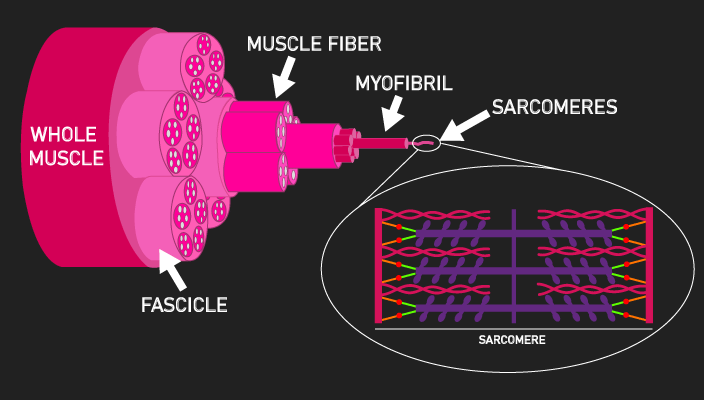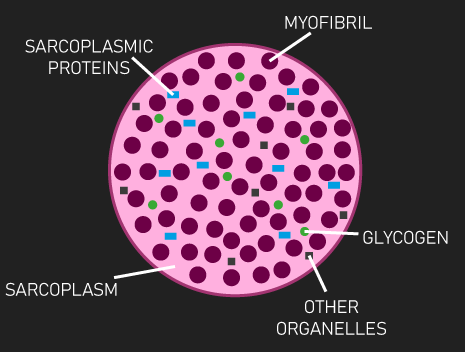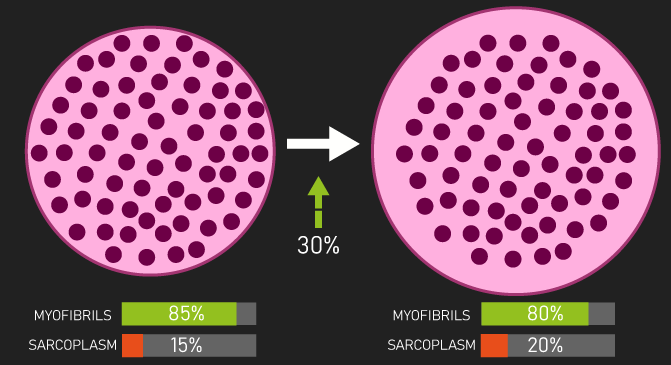
When you resistance train for a sufficient duration, be it with barbells, dumbbells, machines, or even your body weight, your muscles typically increase in size.
But, have you ever wondered what underlying changes within the muscle drive an increase in muscle size?
In this article, we’ll be overviewing all the ways a muscle can increase in size.
Table of Contents
Muscle Growth=Increase In Cross-Sectional Area
In the human body, muscles increase in size by increasing in cross-sectional area.
By my count, there seem to be 5 underlying ways a muscle can increase its cross-sectional area: myofibrillar hypertrophy, sarcoplasmic hypertrophy, myofibrillar packing, muscle hyperplasia, and an increase in muscle length.
Soon we’ll unpack what these ways specifically are and how they create an increase in muscle cross-sectional area.
But first, it is necessary we briefly overview the structure of a muscle.
Structure of a Muscle
Muscles are organized in hierarchical layers.
Within the whole muscle are fascicles, within fascicles are muscle fibers, and within muscle fibers are myofibrils.

Myofibrils are where the magic of muscle contraction happens, they consist of an array of sarcomeres.
Sarcomeres are what generate muscle force.
Specifically, when something called the myosin head extends from the myosin filament and pulls on something called the actin filament towards the M-line, force is generated.

B) The myosin heads extend from the myosin filaments and attach to the actin filaments.
C) The myosin filaments pull the actin filaments towards to M-line, shortening the sarcomere length.
Myofibrillar Hypertrophy
Now that we (hopefully) have an understanding of the structure of muscles and how they produce force, we’re in a good position to unpack what underlies an increase in muscle size.
Starting with myofibrillar hypertrophy, we need to take a deeper look at the muscle fiber level to understand it.
As we’ve mentioned, muscle fibers contain myofibrils, which are what generate force via their sarcomeres.
Everything else within the muscle fiber can be considered the sarcoplasm.
The sarcoplasm largely consists of water but also contains other components, such as glycogen, sarcoplasmic proteins, and non-contractile organelles (like mitochondria, the sarcoplasmic reticulum, and transverse tubules).

Myofibrillar hypertrophy is where the myofibrils and sarcoplasm grow at the same pace, meaning the relative space taken up by the myofibrils and sarcoplasm remains the same.
An example can help us understand this further.
Let us say that 85% of a muscle fiber is taken up by myofibrils, while the remaining 15% is the sarcoplasm. Let’s also say that after training for some duration, the cross-sectional area of this muscle fiber has increased by 30%. However, this larger muscle fiber is still composed of 85% myofibrils and 15% sarcoplasm.

In other words, the myofibrils and sarcoplasm still take up the same relative space because they grew at the same pace.
As muscle fibers are within fascicles, and fascicles are within the whole muscle, an increase in muscle fiber cross-sectional area achieved by myofibrillar hypertrophy increases the cross-sectional area of fascicles, which increases the cross-sectional area of the whole muscle.
As some extra detail, myofibrils may grow by increasing in number or by increasing the cross-sectional area of pre-existing myofibrils.
In the latter case, it’s believed myofibrils can increase their cross-sectional area by adding sarcomeres below or above pre-existing sarcomeres. This phenomenon has been called an increase in sarcomeres in parallel.

Interestingly, as we’ve explored in an article going deeper into the science of myofibrillar hypertrophy, myofibrils may initially increase in cross-sectional area, and once they reach a critical size threshold, they then subsequently split into two (thereby increasing the number of myofibrils). However, as we detailed in that article, this hypothesis is derived from a limited number of animal studies, and thus it is far from a confirmed event.
As for the sarcoplasm, as we’ve explored in our detailed article on sarcoplasmic hypertrophy (coming soon), an increase in various components that lie within the sarcoplasm, such as glycogen and sarcoplasmic proteins, are potential contenders that drive sarcoplasm growth.
Sarcoplasmic Hypertrophy
The discussion on sarcoplasm growth brings us nicely on to sarcoplasmic hypertrophy.
At the muscle fiber level, sarcoplasmic hypertrophy is where the sarcoplasm grows at a greater pace than the myofibrils, meaning the relative space taken up by the sarcoplasm becomes greater.
Again, let us say that 85% of a muscle fiber is taken up by myofibrils, while the remaining 15% is the sarcoplasm. After training for some duration, the cross-sectional area of this muscle fiber increases by 30%. However, this larger muscle fiber is now composed of 80% myofibrils and 20% sarcoplasm.

The sarcoplasm now occupies more relative space in the muscle fiber because it expanded at a greater pace than the myofibrils.
It’s important to emphasize the myofibrils have not decreased in size or number.
Rather, the myofibrils could have very well grown, but it’s just the sarcoplasm grew at a faster pace. Or alternatively, the myofibrils may have not grown at all, while the sarcoplasm only grew.
In the fitness world, sarcoplasmic hypertrophy is often considered controversial. Some suggest it may not occur at all.
However, as we established in our review of the current research, there does appear to be sufficient evidence for the existence of sarcoplasmic hypertrophy.
Myofibrillar Packing
Myofibrillar packing is the opposite of sarcoplasmic hypertrophy, it is where the myofibrils grow at a greater pace than the sarcoplasm, meaning the relative space taken up by the myofibrils becomes greater.
Using the same example, 85% of a muscle fiber is taken up by myofibrils, while the remaining 15% is the sarcoplasm. After training for some duration, this muscle fiber is now composed of 90% myofibrils and 10% sarcoplasm.

The myofibrils now occupy more relative space in the muscle fiber because they grew at a greater rate than the sarcoplasm. This is myofibrillar packing.
Notice how in this example, I did not say the muscle fiber increased in cross-sectional area.
This is because, in theory, myofibrils can grow and not increase muscle fiber cross-sectional area (and hence ultimately the whole muscle’s cross-sectional area).
Having said this, there are two potential ways I’m aware of where myofibrillar packing can still drive an increase in muscle fiber cross-sectional area (and hence whole muscle cross-sectional area).
Firstly, in theory, it’s plausible myofibrils could grow to the point where they push the outer wall of the muscle fiber, causing the muscle fiber to increase in cross-sectional area.
Secondly, the myofibrils grow, but the sarcoplasm also grows to a degree, creating an increase in muscle fiber cross-sectional area.
It’s important to emphasize in this scenario, myofibril growth would outpace the sarcoplasm growth, as this is following the myofibrillar packing definition.
If the sarcoplasm grew at the same rate as the myofibrils, as we know, this would be myofibrillar hypertrophy.
Before moving on, if you’re curious about creating an effective training program for muscle hypertrophy, our high quality partner Alpha Progression can help. It can generate a highly effective program for you, track your workouts live with in-built progression recommendations, provide graphs displaying your long term progress, and it has a massive exercise database with more than 550 exercises.
Click HERE (the link opens in a new tab) to get a free 2 week trial of the apps features. If you like it and go beyond, the link also gives you 20% off a subscription!
We never promote trash at the House of Hypertrophy, so rest assured the app is high quality. The reviews speak to this, 4.8 starts (based on more than 7,000 reviews) on Google play, and 4.9 stars in Apple’s store (based on nearly 400 ratings).
Mini-Review
As a mini-review, we’ve so far explored 3 underlying ways that can drive an increase in muscle cross-sectional area: myofibrillar hypertrophy, sarcoplasmic hypertrophy, and myofibrillar packing.
All three of these are related, as all of them have the capacity to increase muscle fiber cross-sectional area.
The only distinction between them lies in the ratio of myofibril to sarcoplasm growth.
The 4th underlying way that can drive an increase in muscle cross-sectional area, muscle hyperplasia, is more distinct.
Muscle Hyperplasia
Muscle Hyperplasia refers to an increase in the number of muscle fibers within a muscle.
Remember, as muscle fibers are within fascicles, and fascicles are within the whole muscle, an increase in the number of muscle fibers increases fascicle cross-sectional area, which increases whole muscle cross-sectional area.
Now, there appear to be two potential ways in which muscle hyperplasia could occur.
Firstly, completely new muscle fibers could be manufactured and added to fascicles.
Or secondly, pre-existing muscle fibers could split into two, thereby increasing the number of muscle fibers.
We’ve gone into depth on the science of muscle hyperplasia in another article. But, as we saw, the research on where muscle hyperplasia occurs in humans is far from clear.
Animal research suggests that muscle hyperplasia does appear to occur in response to weight training-like stimuli. The question is whether this research applies to humans.
With humans, the problem with studying whether muscle fiber number increases is that it requires researchers to use some method of counting muscle fibers. Current methodologies and equipment do not permit this to be practically or ethically done in humans.
Therefore, the current evidence forces us to conclude that the idea muscle hyperplasia is an underlying way that increases muscle cross-sectional area in humans is tentative.
Increase in Muscle Length
Moving on, an increase in muscle length is the 5th and final way I’m aware of that can increase a muscle’s cross-sectional area.
An increase in muscle length literally refers to an increase in the length of the whole muscle.
Now, in the human body, muscles are attached to bones via tendons.
The attachment locations do not change, and so if the whole muscle length increases, you don’t actually visually witness it.
Rather, due to the fixed attachment locations, the longer muscle would bulge outwards, and this is an increase in cross-sectional area.

What underlies this increase in whole muscle length and subsequently cross-sectional area?
Well, there is a good deal of evidence that resistance training increases the length of fascicles in humans.
Provided fascicles run the length of a whole muscle, an increase in their length would increase whole muscle length.
But, going even deeper, what causes fascicles to increase in length?
The answer most likely lies at the muscle fiber level.
As we know, myofibrils are within muscle fibers.
Myofibrils are believed to be able to increase in length.
Specifically, it’s thought sarcomeres are built and added in a serial line, thereby increasing the myofibril length. This phenomenon has been called an increase in sarcomeres in series.

Along with this increase in myofibril length, although I wasn’t able to find concrete evidence on it, presumably the sarcoplasm would expand lengthwise to support this myofibril length increase, thereby cementing an increase in muscle fiber length.
In this scenario, given the myofibrils and sarcoplasm growth lengthwise at the same pace, it could technically be considered myofibrillar hypertrophy.
Anyway, the increase in muscle fiber length achieved by this would increase fascicle length, which can increase whole muscle length and thus whole muscle cross-sectional area.
And as mentioned, due to a muscle’s fixed attachments in the human body, this results in the bulging of the muscle.
Now, there are some complex considerations here.
Some fascicles (and thus their residing muscles fibers) do not run the entire length of the muscle. Therefore, an increase in the length of fascicles like these may not necessarily be sufficient to increase the whole muscle length.
Furthermore, there could be fascicles that do run the entire length of the muscle, but their residing muscle fibers do not run the entire length of the fascicle. Therefore, an increase in the length of these muscle fibers may not necessarily be sufficient to increase the length of the fascicle, and therefore the length of the whole muscle.
Quite interestingly, as we explored in our article going deep into the science of myofibrillar hypertrophy, there may be specific ways you can train for increasing muscle fiber length.
Specifically, it seems eccentric overload training does a great job at increasing fascicle length.
For those unaware, eccentric contractions are where your muscles produce force while lengthening. Opposite to this is concentric contractions, which are where your muscles produce force while shortening.
Interestingly, your muscles are significantly stronger during eccentric contractions.
This is quite evident with typical exercises. For example, when performing repetitions to failure (the point at which you cannot perform any more repetitions) with a given load on the bench press, you fail during the lifting phase of the exercise, not the lowering phase.
The lifting phase is where the muscles are concentrically contracting, while the lowering phase is where the muscles are eccentrically contracting.
Eccentric overload training refers to using some method that enables you to lift heavier loads on the lowering phase of an exercise, thereby overloading and meaningfully challenging the eccentric muscular contractions. There are a variety of ways this can be achieved, either by using some technique or special equipment.
For example, if you’re not strong enough to perform a pull-up, simply jumping up on the bar and controlling the lowering phase is an example of eccentric overload training.
Now, although eccentric overload training may be an excellent way to increase muscle fiber length, there is evidence suggesting that this adaptation may be limited.
As explored in our article going deep into the science of myofibrillar hypertrophy, two studies (one & two) suggest that fascicle length increases after 5-8 weeks of training, but no increases thereafter.
Now, these are only two studies, but perhaps this evidence indicates that your ability to increase muscle fiber length may be limited. Hopefully future research adds to this area.
Summary
So there we have it, we’ve just overviewed the 5 underlying ways in which a muscle may increase in size.
As we’ve mentioned, the idea hyperplasia occurs in humans is tentative. Also, an increase in whole muscle length could potentially be limited.
Therefore, it’s quite likely the ways behind an increase in muscle fiber cross-sectional area are what commonly drive an increase in whole muscle cross-sectional area.
That is myofibrillar hypertrophy, sarcoplasmic hypertrophy, or myofibrillar packing.
In another article, we evaluated the evidence on these 3 underlying ways of muscle fiber growth. More precisely, we explored which of these most commonly occur with resistance training and whether you can specifically train for each.
Remember to feel free to check out the Alpha Progression App if you’re interested. Also feel free to check out our free bench press e-book below.

